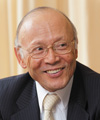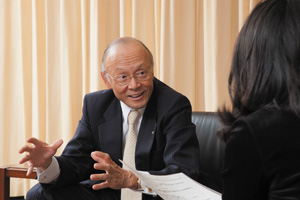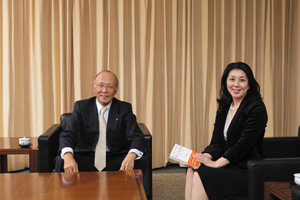 |
|
|
|
|
|
View from the Top Vol. 10, No. 1, pp. 1–5, Jan. 2012. https://doi.org/10.53829/ntr201201tp1  Software-oriented, Speedy, and Globally Minded R&D––Providing Cloud, Smart-community, Fixed-mobile-convergence, and Disaster-recovery Solutions Through the Total Power of the NTT GroupOverviewFor our first interview of 2012, we had the pleasure of talking again with Noritaka Uji, NTT Representative Director and Senior Executive Vice President. We asked him about this year's strategy toward service creation in the NTT Group including measures for recovering from the Great East Japan Earthquake and efforts to solve social problems through the use of information and communications technology (ICT). Recognizing again the importance of ICT: Developing an infrastructure and service lineup robust to disasters though a group-wide effort—Mr. Uji, please tell us how the lessons learned from last year’s Great East Japan Earthquake—an unprecedented disaster in the history of Japan—will be applied to this year’s technology strategy. The Great East Japan Earthquake reminded not only us at NTT but also society on the whole of the critical importance of communications. When the earthquake hit, many people had their mobile phones with them just as they would their wallets or purses. Needless to say, there is nothing more important at the time of a disaster than to be able to check on the well-being of loved ones. There was therefore an urgent need to restore disrupted communication services as quickly as possible. This shows that, these days, communications is a vital social infrastructure, at least as important as water and gas. In response to this need, we are working to develop a network and service lineup robust to disasters along three main directions. First, we are endeavoring to set up a network highly robust to disasters and to develop ways of achieving early service restoration in stricken areas. To this end, we are exploring various means to achieve a highly reliable network resistant to traffic congestion. These include dispersing important communication functions over a number of regions and establishing many transmission routes, installing disaster-oriented mobile-phone base stations that can cover a much wider area than ordinary ones, and upgrading emergency battery capacity in base stations from several hours (the current standard) to 24 hours so that communications can be maintained during extended outages of the commercial power supply. We are also planning to study network architectures that promote the convergence of fixed-line and wireless communication (fixed-mobile convergence (FMC)) and to research and develop highly efficient storage batteries. Moreover, we have been developing compact and portable, easy-to-use satellite communications equipment as an alternative means of communication that can be set up quickly after a disaster hits. This equipment is scheduled to be introduced soon. Second, we are working on a means of information distribution after a disaster so that people can quickly check on the well-being of others. To deal with congestion in the network caused by many people attempting to make calls with their mobile phones at the same time, we will be launching a service in March 2012 that enables speech to be converted to digital data for delivery over the packet network. I’d like to mention here that the message board service developed at the time of the Great Hanshin-Awaji Earthquake of 1995 was also used to good effect in last year’s Great East Japan Earthquake, but to make it even easier for users to check on each other, we will be developing ways of doing so by multiple means including personal computers, smartphones, and mobile phones. Third, we aim to provide medical and governmental public services after a disaster hits and during the restoration period. For example, we aim to provide remote health consultations for people in stricken areas and refuge centers using videoconferencing functions, to establish a number-based identification system for use after a disaster, to create a list of people requiring special support during a disaster including disaster victims themselves, and to provide people with effective support in putting their lives back in order. In relation to these efforts, we are already providing local governments with detailed map data that we have been using for managing utility poles, manholes, and other elements of the telecommunications infrastructure to assist them in their restoration and reconstruction efforts. And we are studying ways of linking this infrastructure map data with a hazard map to create communities robust to disasters. In short, we are working to achieve a safe and secure society through the combined effort of the whole NTT Group including its research and development (R&D) activities.
A drive toward service creation fueled by the cloud, the smart-community concept, and FMC—This is the final year of the NTT Group Medium-term Management Strategy announced in 2008. Could you update us on its progress? This medium-term management strategy declared the NTT Group’s intention of becoming a service creation group. To this end, we have been actively pursuing a transition from a business structure centered on legacy systems like the telephone to one focused on IP (Internet protocol) systems, solutions, and new business fields. As a result, earnings from IP systems and solutions are on course to make up about 70% of total earnings by the end of fiscal year 2011. One reason for this is that we have expanded broadband services on both the fixed and mobile networks. On the fixed network, the Next Generation Network (NGN) is now being provided in all existing areas where optical network services are available, and on the mobile network, the high-speed, high-capacity Long Term Evolution (LTE) service called Xi (Crossy) is now in operation and providing a world-class broadband environment. We are expanding user services on these networks as part of the trends for service convergence, such as FMC, and a paradigm shift. For example, the number of subscribers to the Hikari TV and FLET’S TV video services combined reached 2.43 million by the end of September 2011. Moreover, a Home ICT service called FLET’S Joint, which enables home appliances to be controlled over the network, was launched in August 2011, and the NOTTV multimedia broadcasting service for mobile phones is scheduled to be launched in April 2012. As for our globalization efforts, it appears that we will achieve our target of US$10 billion in overseas sales by FY2012: a year ahead of schedule. Although we are now in the final year of this medium-term management strategy announced in 2008, there are new challenges to face. To move on to the next step, I would like to accelerate our service creation efforts. —The Medium-term Management Strategy appears to have been a success, but what will be the strategy for service creation from here on? To begin with, there’s the cloud. Cloud services are being developed through various collaborative efforts among the group companies leveraging their characteristics and strengths of each. In addition to corporate-oriented services now being undertaken by NTT Communications and NTT DATA, there is also a cloud service that can be used by smartphones that was launched by NTT DOCOMO in April 2011. This service has become a case study of how the web platform developed by NTT DATA INTRAMART can be used across the entire NTT Group. NTT EAST and NTT WEST are also expanding cloud services using their own datacenters. In addition to business, NTT is also promoting use of the cloud in the public sector. In the field of medical care, the NTT holding company and NTT EAST have joined forces to develop a cloud-type remote health consultation service called Hikari Health Consultation. This service was first introduced in Tono city, Iwate prefecture, and then expanded throughout Japan from September 2011. Meanwhile, in the field of education, an education-oriented cloud has been in use since 2011 to provide digital materials and hold interactive classes using tablet devices in ten elementary and junior high schools throughout Japan. And in government, we are promoting local-government clouds with the aim of making operations across multiple municipalities more efficient and administrative clouds to make government services more convenient for users. Looking forward, we aim to provide an end-to-end one-stop service that includes construction and maintenance support for networks, platforms, and applications from a user terminal. We will also undertake technology development from various perspectives. For example, we plan to expand virtualization techniques beyond servers to the network, enable flexible and speedy service provision combining servers and the network, reduce system construction and operating costs by using open-source-software technologies, and enhance security through cryptographic and trail-management techniques. Furthermore, in collaboration with overseas companies in the NTT Group, we will pursue the global expansion of services using global networks and overseas datacenters. Parallel processing using the cloud will make it possible to inexpensively and rapidly analyze huge amounts of data, which is known as big data. This data might include users’ web search histories, data posted on social networking services, and data collected from various types of devices and sensors in machine-to-machine communication. We expect such analysis of big data to create new value in many forms. For example, we can envision the analysis of location information exchanged between mobile phones and base stations to reveal how people behave at the time of an earthquake or other natural disaster. Such knowledge could be useful in disaster prevention planning. The storage and analysis of other kinds of information, such as large quantities of meteorological data and past medical cases and health information, also hold many possibilities. Analysis results could be used, for example, in corporate marketing, urban planning, and the agriculture and medical-care fields. The potential for creating new value is infinite. —I can see that the cloud is taking on an important role within the NTT Group. What about activities targeting the environment and energy? As you know, a shortage of electrical power has become an issue in our society in the wake of last year’s earthquake. As an ICT operator that uses a considerable amount of power in our business operations, we have a social responsibility to reduce power consumption. At the same time, we are working on ways of saving energy in society through the adept use of ICT. These efforts will help reduce the load on the environment. For example, we are working on a variety of environmental solutions taking advantage of the individual strengths of various NTT Group companies. These include a power visualization service for reducing power consumption in homes, condominium complexes, and office buildings, a car-sharing service using electric cars, and a mega-solar solution for constructing and operating a solar power generation system. Likewise, as part of our R&D efforts, we are researching and developing ways of reducing power consumption even further in network equipment, such as in home-installed optical network units (ONUs) that convert optical signals to electrical signals, and we are studying energy-management techniques for controlling air conditioning and power supplies according to the current load on ICT equipment. In future R&D, we intend to expand upon these activities toward the provision of home energy management and the creation of smart communities. The idea behind home energy management is to interconnect a variety of home appliances, information devices, and power generation and storage equipment in combination with Home ICT services to achieve optimal control of energy use inside the home. The idea behind a smart community, meanwhile, is to achieve optimal control of electrical-power supply and demand throughout a community by linking the energy infrastructure in the community with the ICT infrastructure and using the cloud to analyze and visualize information such as current supply-and-demand conditions. We expect smart-community technology to be useful in creating communities robust to disasters and good at disaster recovery while being environmentally friendly. —Sales of smartphones and tablet computers are exploding. How will NTT respond to this trend? About 2.5 million smartphones and tablets were sold in FY2010 in Japan, and while the initial projection for FY2011 was about 6 million units, it now seems that about 8.5 million units will be sold. This change in consumer taste is occurring much faster and on a larger scale than we expected—consumers are saying that they want to use a smartphone or tablet because it enables them to do what they’ve been doing on their computer anytime and anywhere. We can expect the spread of mobile terminals to expand the ways in which the cloud is used in the corporate and public services that I touched upon earlier. And in the home as well, we can envision mobile terminals and the cloud finding use in the kitchen and living room such as for enabling the purchase of products from online supermarkets and visualizing power usage. However, users must be able to use such services in a comfortable, stress-free manner, and to this end, it is essential that fixed and mobile network services be combined in a seamless, transparent manner. For example, we are accelerating the deployment of a service environment in which users automatically use Wi-Fi connected to a high-speed optical line when indoors and the mobile network when outdoors. We are also looking to develop services that support the multi-device concept in which users can receive the same service regardless of the type of terminal, which could be a home appliance such as a TV set when indoors and a mobile terminal or even digital signage when outdoors. In the case of IPTV, for example, a multi-device service would enable video content to be viewed with a smartphone or tablet in the same way that it is viewed on TV. At present, however, this would require the content provider to provide different versions of certain content to suit different terminals, which would increase development time and thus drive up costs. A solution to this problem can be found in next-generation web technology (HTML5), which will enable a web browser to absorb terminal differences so that any item of content can be used on a variety of terminals. We are researching and developing applications and platforms that will incorporate this technology, which is now in the process of being standardized. In this way, by enabling an individual to use the same terminal or service anytime and anywhere, we can compile a usage history, which can be used to create personalized services and new, attractive services such as a concierge function.
Software-oriented, speedy, and globally minded R&D—Mr. Uji, could you leave us with some words about your aspirations for this year? First of all, responding to changes in the world in a timely manner is not as easy as it sounds. In R&D, some sort of drastic change is needed to respond to the times. This year, I would like to see our R&D evolve on the basis of the keywords software-oriented, speedy, and globally minded. Software-oriented means accelerating service development and improving quality and security through software technology as our business areas expand. Being software-oriented is crucial to keeping up with expanding cloud services and the trend toward service convergence. Speedy refers to the need for accelerating service development to keep up with world changes in a severely competitive mobile-services field and for revolutionizing R&D itself in accordance with social changes. Globally minded includes efforts to increase overseas sales but also means keeping our eyes on overseas trends in markets and technologies and reflecting those trends in service development. In this regard, collaboration with newly added overseas group companies and overseas researchers is essential. In terms of software development, I particularly want to expand research on the west coast of North America from a global perspective. We must pursue R&D with a sense of urgency as the world moves forward with unbelievable speed. With about 3000 researchers in the NTT R&D Laboratory Group (under the holding company) and about 6000 researchers and developers across the entire NTT Group, NTT R&D is of a world-class level—it is the source of our competitive power and potential for growth. My goal here is to instigate a rapid succession of ICT innovations in the NTT Group.
Interviewee profileCareer highlightsNoritaka Uji joined Nippon Telegraph and Telephone Public Corporation (now NTT) in 1973. He handled tasks related to NTT privatization and startup business development. In 1988, he moved to NTT DATA, where he was initially in charge of planning and developing information systems for private enterprises. He then served in various managerial roles including Director of the Next-Generation Information Services Sector, Senior Vice President and Director of Business Planning, and Senior Vice President and Director of Enterprise-related Sectors. Building on these experiences, he assumed the post of Senior Executive Vice President in 2005. He began serving in his present position in 2007. |
|










